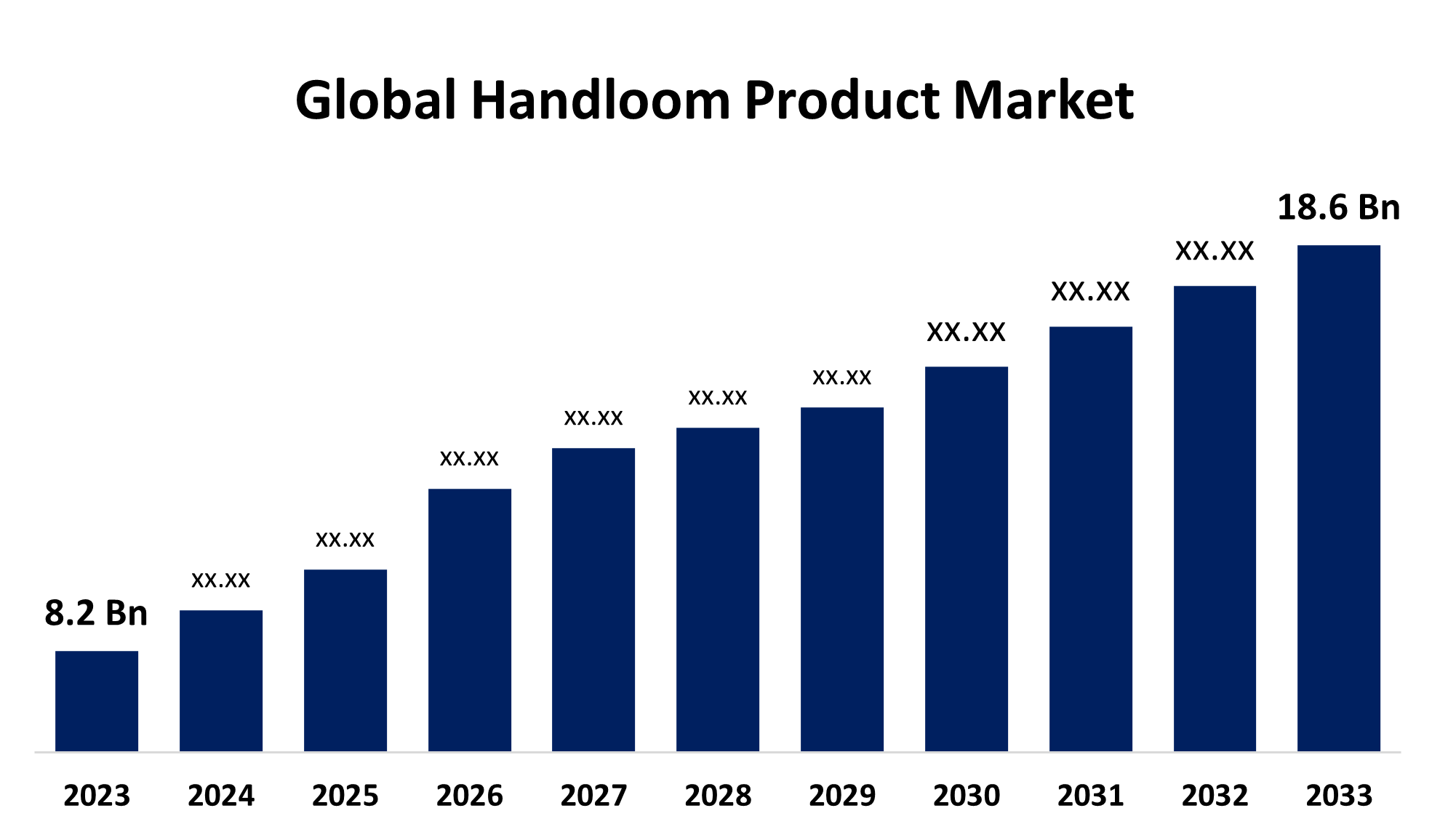Global Handloom Product Market Size, Share, and COVID-19 Impact Analysis, By Type (Sarees, Apparel & Accessories, Bedding & Bath, Carpet, Mats, & Rugs, and others), By Material (Cotton, Silk, Linen, and Wool), and By Region (North America, Europe, Asia-Pacific, Latin America, Middle East, and Africa), Analysis and Forecast 2023 - 2033
Industry: Consumer GoodsGlobal Handloom Product Market Insights Forecasts to 2033
- The Global Handloom Product Market Size was estimated at USD 8.2 Billion in 2023
- The Market Size is Expected to Grow at a CAGR of around 8.54% from 2023 to 2033
- The Worldwide Handloom Product Market Size is Expected to Reach USD 18.6 Billion by 2033
- North America is expected to grow the fastest during the forecast period.

Get more details on this report -
The Global Handloom Product Market Size is expected to cross USD 18.6 Billion by 2033, growing at a CAGR of 8.54% from 2023 to 2033. The market for handloom products has an opportunity for growth due to the incorporation of digital technology, which will increase accessibility, market reach, and brand awareness for both producers and artisans.
Market Overview
The industry or commercial area where products made with handloom processes are purchased and sold is known as the Handloom Product market. Textiles like fabrics, sarees, scarves, towels, and carpets are examples of handloom product, which are made on hand-operated looms by trained artisans. The market for handloom product is a thriving and essential segment of the larger textile industry, with roots in centuries-old customs of artisanal craftsmanship and cultural legacy. The market for handloom product is largely dependent on shifting customer tastes, such as an increasing need for products made ethically and sustainably. Consumer demand for distinctive, sustainable, and culturally meaningful products is driving the growth of the handloom product market. A confluence of environmental, ethnic, and economic elements is responsible for the market's expansion. First and foremost, consumer preferences are shifting toward eco-friendly product and artisanal craftsmanship. Adoption in the international market is anticipated to be driven by supportive activities from the government and nonprofit groups aimed at conserving and safeguarding the region's cultural history.
Report Coverage
This research report categorizes the handloom product market based on various segments and regions forecasts revenue growth and analyzes trends in each submarket. The report analyses the key growth drivers, opportunities, and challenges influencing the handloom product market. Recent market developments and competitive strategies such as expansion, type launch, development, partnership, merger, and acquisition have been included to draw the competitive landscape in the market. The report strategically identifies and profiles the key market players and analyses their core competencies in each sub-segment of the handloom product market.
Global Handloom Product Market Report Coverage
| Report Coverage | Details |
|---|---|
| Base Year: | 2023 |
| Market Size in 2023: | USD 8.2 Billion |
| Forecast Period: | 2023 – 2033 |
| Forecast Period CAGR 2023 – 2033 : | 8.54% |
| 023 – 2033 Value Projection: | USD 18.6 Billion |
| Historical Data for: | 2019-2022 |
| No. of Pages: | 233 |
| Tables, Charts & Figures: | 101 |
| Segments covered: | By Type, By Material, By Regional Analysis and COVID-19 Impact Analysis. |
| Companies covered:: | Dhananjay Creations, Manisha Silk Weaves, Maheshwari Handloom Works, Global Floor Furnishers, GoCoop, Dream Home Carpets Pvt. Ltd., Sri Laxmi Narasimha Handloom Sarees, Shree Jee, Chandan Rugs, Medusa Exim, and Other Key Vendors. |
| Pitfalls & Challenges: | COVID-19 Impact, Challenges, Future, Growth, & Analysis |
Get more details on this report -
Driving Factors
A revitalized respect for traditional workmanship, a trend toward environmentally friendly products, shifting consumer preferences, and a growing focus on cultural art and heritage conservation are some of the factors driving the increased demand for the handloom product market. Encouraging innovation, improving product quality, and expanding market access for handloom craftsmen, government support has been crucial in driving the growth of the handloom product market. Increased production, distribution, and sales of handloom textiles and clothing globally have been driven by the growing demand for sustainable fashion.
Restraining Factors
The market for handloom product is also being restricted by several factors, including a lack of operating capital, a shortage of suitable raw materials, a lack of entrepreneurial skills among craftsmen, a lack of awareness about suitable technologies, and competition from machine-made products.
Market Segmentation
The handloom product market share is classified into type and material.
- The sarees segment held the largest share in 2023 and is expected to grow at a significant CAGR during the forecast period.
Based on the type, the handloom product market includes sarees, apparel & accessories, bedding & bath, carpet, mats, & rugs, and others. Among these, the sarees segment held the largest share in 2023 and is expected to grow at a significant CAGR during the forecast period. Handmade sarees are growing increasingly common among young adults as a result of social media and venues for short videos. The Chanderi, Banarasi, Maheshwari, and Tussar silks are among the most widely used Indian handloom textiles for sarees.
- The cotton segment held the largest share in 2023 and is expected to grow at a significant CAGR during the forecast period.
Based on the material, the handloom product market is divided into cotton, silk, linen, and wool. Among these, the cotton segment held the largest share in 2023 and is expected to grow at a significant CAGR during the forecast period. Cotton is used in almost every kind of clothing, including shirts, dresses and Co-Ord sets, sarees, kurtas and kurtis, dupattas, stoles, and scarves, among many other products.
Regional Segment Analysis of the Handloom Product Market
- North America (U.S., Canada, Mexico)
- Europe (Germany, France, U.K., Italy, Spain, Rest of Europe)
- Asia-Pacific (China, Japan, India, Rest of APAC)
- South America (Brazil and the Rest of South America)
- The Middle East and Africa (UAE, South Africa, Rest of MEA)
Asia Pacific is anticipated to hold the largest share of the handloom product market over the predicted timeframe.

Get more details on this report -
Asia Pacific is anticipated to hold the largest share of the handloom product market over the predicted timeframe. The Asia Pacific market has developed to combine traditional methods with contemporary advancements, improving a long history of textile production and workmanship. The handloom fabrics of Bangladesh, Indonesia, and India are well known. These fabrics, which are frequently made on traditional wooden looms, feature vivid colors and elaborate designs that are specific to each region. The Asia Pacific region governments and organizations there have realized how important it is to preserve and promote this traditional craft.
North America is expected to grow at the fastest CAGR growth of the handloom product market during the forecast period. The growing demand for locally produced and sustainable handcrafted products is the reason for this in North America. The workmanship and distinctiveness of these products, which are frequently created utilizing ancient methods and natural fibers, are becoming recognized and appreciated by Western consumers. The North American market is a products thing since it will probably encourage traditional artisanship, eco-friendly operations, and intercultural understanding, which drives the market expansion.
Competitive Analysis:
The report offers the appropriate analysis of the key organizations/companies involved within the handloom product market along with a comparative evaluation primarily based on their type of offering, business overviews, geographic presence, enterprise strategies, segment market share, and SWOT analysis. The report also provides an elaborative analysis focusing on the current news and developments of the companies, which includes type development, innovations, joint ventures, partnerships, mergers & acquisitions, strategic alliances, and others. This allows for the evaluation of the overall competition within the market.
List of Key Companies
- Dhananjay Creations
- Manisha Silk Weaves
- Maheshwari Handloom Works
- Global Floor Furnishers
- GoCoop
- Dream Home Carpets Pvt. Ltd.
- Sri Laxmi Narasimha Handloom Sarees
- Shree Jee
- Chandan Rugs
- Medusa Exim
- Others
Key Target Audience
- Market Players
- Investors
- End-users
- Government Authorities
- Consulting And Research Firm
- Venture capitalists
- Value-Added Resellers (VARs)
Recent Development
- In January 2025, the government's textile minister launched the new permanent campus of the Indian Institute of Handloom Technology in the Nadia region of West Bengal to upskill Indian youth and strengthen the nation's handloom industry.
Market Segment
This study forecasts revenue at global, regional, and country levels from 2023 to 2033. Spherical Insights has segmented the handloom product market based on the below-mentioned segments:
Global Handloom Product Market, By Type
- Sarees
- Apparel & Accessories
- Bedding & Bath
- Carpet, Mats, & Rugs
- Others
Global Handloom Product Market, By Material
- Cotton
- Silk
- Linen
- Wool
Global Handloom Product Market, By Regional Analysis
- North America
- US
- Canada
- Mexico
- Europe
- Germany
- UK
- France
- Italy
- Spain
- Russia
- Rest of Europe
- Asia Pacific
- China
- Japan
- India
- South Korea
- Australia
- Rest of Asia Pacific
- South America
- Brazil
- Argentina
- Rest of South America
- Middle East & Africa
- UAE
- Saudi Arabia
- Qatar
- South Africa
- Rest of the Middle East & Africa
Need help to buy this report?